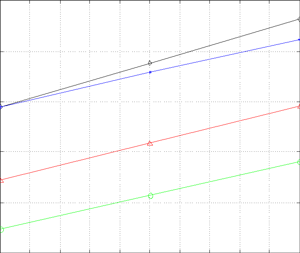Sum-rate performance of massive MIMO systems in highly scattering channel with semi-orthogonal and random user selection
DOI:
https://doi.org/10.3103/S0735272718120026Keywords:
massive MIMO, sum-rate, random user selection, semi-orthogonal user selection, precodingAbstract
The sum-rate performance of a massive MIMO system is dependent on the adequate user and antenna selection techniques. It is best when all the selected users are mutually orthogonal (MOU) and antennas are selected based on maximum channel gain. In the case, when number of antennas in massive MIMO is approximately hundreds, the computational complexity cost in joint user and antenna selection is very high. Semi-orthogonal user selection (SUS) is preferred to reduce interference and complexity cost. In highly scattering Rayleigh fading channel random user selection (RUS) technique can be used because of small loss of system sum-rate compared to SUS and MOU techniques. In this paper we propose a joint user and antenna selection algorithm where users are scheduled using semi-orthogonality measure and antenna selection is based on maximum channel gain. In addition, an algorithm for joint user and antenna selection is reported here with RUS for user selection and maximum channel gain for antenna selection. We explore the system sum-rate performance of a massive MIMO system using these algorithms for the case of a highly scattering Rayleigh fading channel. We consider various precoding techniques MMSE, ZFBF, and MRT and a range of SNR. We also explore the effect of spatial and multiuser diversity on system sum-rates using proposed algorithms. The sum-rate obtained by algorithms-1 is greater than the algorithm-2 about 1–3% but second one is much simpler.References
- MARZETTA, T.L. “Noncooperative cellular wireless with unlimited numbers of base station antennas,” IEEE Trans. Wireless Commun., v.9, n.11, p.3590, Nov. 2010. DOI: https://doi.org/10.1109/TWC.2010.092810.091092.
- ALI SHEIKH, T.; BORA, J.; HUSSAIN, A. “A survey of antenna and user scheduling techniques for massive MIMO-5G wireless system,” Proc. of Int. Conf. on Current Trends in Computer, Electrical, Electronics and Communication, 8-9 Sept. 2017, Mysore, India. IEEE, 2017, p.578-583. DOI: https://doi.org/10.1109/CTCEEC.2017.8455177.
- AL-RAWI, M.; AL-RAWI, M. “Performance of massive MIMO uplink system over Nakagami-m fading channel,” Radioelectron. Commun. Syst., v.60, n.1, p.13, 2017. DOI: https://doi.org/10.3103/S0735272717010022.
- LIU, H.; GAO, H.; YANG, S.; LV, T. “Low-complexity downlink user selection for massive MIMO systems,” IEEE Syst. J., v.11, n.2, p.1072, Jun. 2017. DOI: https://doi.org/10.1109/JSYST.2015.2422475.
- MAO, J.; GAO, J.; LIU, Y.; XIE, G. “Simplified semi-orthogonal user selection for MU-MIMO systems with ZFBF,” IEEE Wireless Commun. Lett., v.1, n.1, p.42, Feb. 2012. DOI: https://doi.org/10.1109/WCL.2012.010912.110119.
- CHIA, S.; GASPARRONI, M.; BRICK, P. “The next challenge for cellular networks: Backhaul,” IEEE Microw. Mag., v.10, n.5, p.54, Aug. 2009. DOI: https://doi.org/10.1109/MMM.2009.932832.
- XU, G.; LIU, A.; JIANG, W.; XIANG, H.; LUO, W. “Joint user scheduling and antenna selection in distributed massive MIMO systems with limited backhaul capacity,” China Commun., v.11, n.5, p.17, May 2014. DOI: https://doi.org/10.1109/CC.2014.6880457.
- DONG, Y.; TANG, Y.; SHENZHEN, K. Zhang. “Improved joint antenna selection and user scheduling for massive MIMO systems,” Proc. of 16th IEEE Int. Conf. on Computer and Information Science, 24-26 May 2017, Wuhan, China. IEEE, 2017, p.69-74. DOI: https://doi.org/10.1109/ICIS.2017.7959971.
- GAO, Y.; JIANG, W.; KAISER, T. “Bidirectional branch and bound based antenna seletion in massive MIMO systems,” Proc. of 26th Annual Int. Symp. on PIMRC, 30 Aug.-2 Sept. 2015, Hong Kong, China. IEEE, 2015, p.563-568. DOI: https://doi.org/10.1109/PIMRC.2015.7343363.
- BENMIMOUNE, M.; DRIOUCH, E.; AJIB, W.; MASSICOTTE, D. “Joint transmit antenna selection and user scheduling for massive MIMO systems,” Proc. of IEEE Wireless Communication and Networking Conf., 9-12 Mar. 2015, New Orleans, LA, USA. IEEE, 2015, p.381-386. DOI: https://doi.org/10.1109/WCNC.2015.7127500.

Downloads
Published
2019-01-02
Issue
Section
Research Articles

